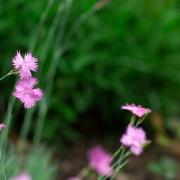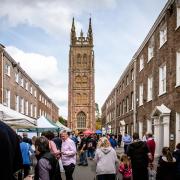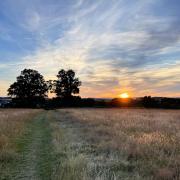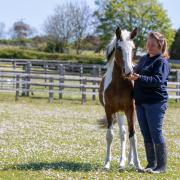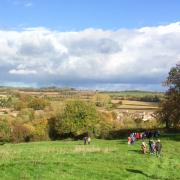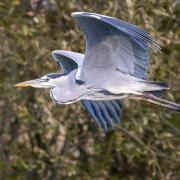Follow a 15-mile trail across our historic landscape in search of an ancient forest.
‘Selwood Forest? Surely you mean Sherwood Forest?!’ Fortunately for all the walkers in Somerset out there, I do mean Selwood, and although Robin Hood and his merry men may not be in our locality, what we do have instead is the legend of King Alfred and the knowledge that he and his men took refuge here in AD 878. But, before you head off to search this ancient wood in Google Maps, I must give you the heads up that your search will be fruitless, even the OS maps app draws a blank because this forest is indeed ancient and subsequently not currently recognised on recent cartography. Our landscape has changed so dramatically since Selwood’s prime existence, that it is, at present, a legacy which is undergoing rejuvenation. This ancient forest may once have covered the lands from Bruton in the west to Warminster in the east, and from Frome in the north to Shaftesbury in the south but many influences have affected our landscapes over the years and this area has not been excluded from that. For now, the Forest of Selwood is an independent charity where the members are committed to reviving nature in this very special and deeply historic landscape whilst safeguarding against increasing habitat loss and species decline.

Co-founder of the charity, Ewan Jones says, ‘The Forest of Selwood (Saxon Sealwudu) was an intimidating border, dividing the West Saxons, to the East, from the post-Roman Britons of Dumnonia, to the West. After King Cenwalh’s victory atop Pen Ridge in 658 pushed the boundary, of what became Somerset, west to Parrett, his cousin Aldhelm was seated in Sherborne as ‘Bishop of the west of the wood’. The source of four rivers, the Brue, Frome, Wylye and Stour, beneath the site of the modern Alfred’s Tower, would have exerted a powerful pull on both British and West Saxon imaginations.’
And so it was, with tales of marauding Danes in the forefront of my mind that I decided to strike out on footpaths crossing the lands in which the Battle of Ethandune would have taken place over a thousand years ago. The route I followed in order to explore Selwood Forest began at the National Trust’s Stourhead estate and finished on the edge of the Mendip Hills in Frome. I weaved through Castle Wood and King’s Wood before heading out into the open farmlands of Brewham and Witham Friary, tracking the River Frome past the medieval village of Marston, ending fifteen miles later in Frome. There are plentiful options for walkers to explore the Forest of Selwood and, with careful planning, you can even eco-hike a large section of it by using train links in Bruton and Frome.

To begin a walk on the eastern border of our county at Stourhead is always a walker’s delight, there are a myriad of ways in which to explore the 2,650-acre estate. In order however to retrace the steps of the fyrds of Wessex, and to understand the historical nature of Selwood, I had King Alfred’s Tower in my sights as I headed deep into the forest. Philip Niemand, the General Manager for Stourhead says, ‘The Stourhead estate does not exist in isolation. Understanding how it contributes to the wider landscape is an important first step in developing our vision. Stourhead lies within the ancient Forest of Selwood, a royal hunting forest dating back to at least 878. Elements of the forest are still visible today at Stourhead, in its remnant ancient woodland, veteran trees, hedgerows and flower-rich meadows. Our vision is inspired by, and aligns with, the Forest of Selwood charity and together we aim to revive and enhance wildlife, slow climate change and connect people with this dynamic landscape which gives us all a sense of identity with the land’ (nationaltrust.org.uk)
As I broke cover of the trees and reappeared into the day’s light, my trail skirted the peaceful village of Brewham. Across the watershed between the rivers Brue and Frome, farms are returning to a more natural habitat, by the work of animals such as beavers and native cattle. I was delighted to hear the snuffles of free-ranging pigs the other side of the hedgerow before I headed on to Witham Friary. If you’re after refreshment, this is your first pit stop opportunity. Sadly for me, I arrived before the Seymour Arms was open that day, but a flask of tea whilst sitting in the shadows of the only remaining Carthusian place of worship in the UK was a welcome alternative, if a little apt being that St Mary’s is a place of pilgrimage! Of course, Witham Friary is also well renowned in Somerset for being the hiding place of the Frome Hoard. Over 50,000 Roman coins were discovered by a metal detectorist in 2010 and can now be seen in Taunton at the Museum of Somerset. (swheritage.org.uk) Dating from AD253 it seems incomprehensible that the hoard lay undiscovered 600 years before King Alfred was even in town!

After walking through the village, I picked up the footpath which runs parallel to the River Frome. Known as Long Ham Meadows, the Forest of Selwood have, through a philanthropic loan and generous donations from individuals, secured ownership of 14.5 acres of land here. The charity will provide a significant and exciting new space for wildlife, and allow species-poor grassland to develop into a rich and thriving mix of wet woodland, grassland and damp scrub. Trustee Simon Nash says, ‘The site is already used by a host of wildlife including beavers, Red Kite, Kingfishers and Dippers. In the future Long Ham Meadows will benefit many of the UK’s critically endangered species including brown trout, otter, and the water vole.’ Improving the quality of the river water is also high on the agenda, and as a result, the charity is working very closely with volunteers from Friends of the Somerset Frome. (friendsoftheriverfrome.co.uk) Ecologist Sue Everett says, ‘Five rivers have their source in the area known as the Forest of Selwood, with the largest area occupied by the catchment of Somerset’s River Frome. Considerable pressure on the quality of the freshwater and riverside habitats has been made over the years, so we are working together to improve the quality of the river for people, nature and the wider environment.’
Before you reach Frome there is the option to follow a footpath which leads to the ancient village of Marston and adjoining Marston Park. Jill Butler, Chair of the Forest of Selwood charity says, ‘This is a very old park with a superb collection of open-grown ancient and other veteran trees. Too often the biodiversity value of historic parkland is overlooked but it is one of Britain's most important habitats and of international value. Very few parks of the size and age of Marston Park still exist outside the UK and with its old trees reaching back into the past it gives us a rare glimpse of the true wildwood that can be traced in documents back to early Anglo-Saxon times, but in reality actually goes back to the last ice-age.’

As I walked through this, our historic landscape of Somerset, I wished for the fantastical time machine which would make it possible to witness the forest as it once was; how did it look for those who previously fought battles, sought refuge or even buried treasure here?! The spirit and legacy of Selwood certainly still survives and it is with the help of the Forest of Selwood charity and their connected partners that our heritage has a chance of being preserved whilst they also focus on reviving and enhancing the rivers and land of which we are the current custodians. (forestofselwood.org)





